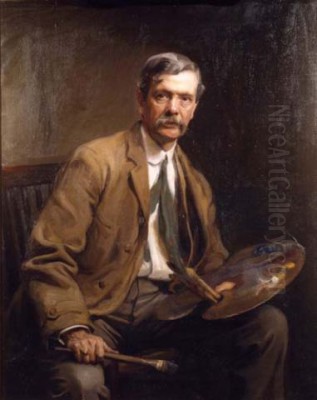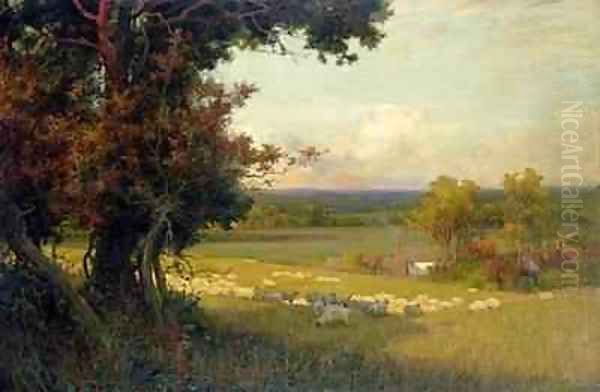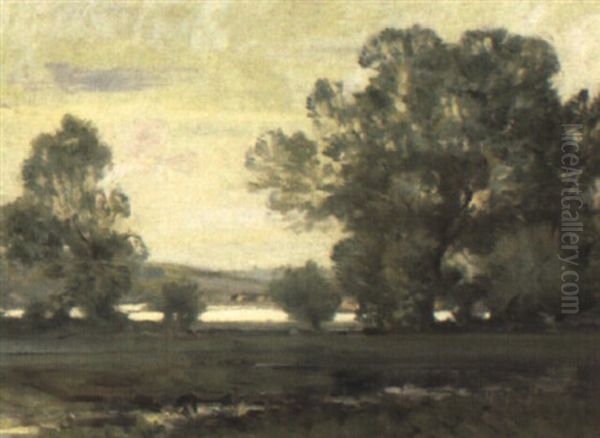
Sir Alfred East stands as a significant figure in the landscape painting tradition of late Victorian and Edwardian Britain. A prolific artist, teacher, and influential arts administrator, East captured the subtle beauties and romantic moods of the natural world, primarily focusing on the English countryside but also venturing further afield. His work, deeply influenced by the French Barbizon School yet firmly rooted in British sensibilities, earned him considerable acclaim during his lifetime, including a knighthood and the presidency of the Royal Society of British Artists. This exploration delves into the life, art, and legacy of a painter dedicated to interpreting the soul of the landscape.
Early Life and Artistic Awakening in Kettering
Alfred East was born on December 15, 1844, in the market town of Kettering, Northamptonshire. His family was involved in the local shoe trade, a dominant industry in the region, with both his father and brother active in the business. Growing up in this commercial environment, young Alfred showed an early inclination towards art, a path quite distinct from his family's pursuits. An anecdote survives of him earning two shillings at school for illustrating a geology lecture with drawings of prehistoric creatures, hinting at a nascent talent and interest in visual representation.
Despite this early promise, his formal education at Kettering Grammar School did not include art instruction. Furthermore, his parents, perhaps reflecting the practical mindset of their milieu, did not initially view art as a viable profession. Consequently, upon leaving school around the age of 15, East entered the family shoe business, eventually working for his brother's firm and later serving as a sales representative based in Glasgow. This period spent in commerce, however, did not extinguish his artistic passion.

The pull towards art proved irresistible. In his thirties, a time when many careers are already established, East made the decisive commitment to become a professional artist. This marked a significant departure from his commercial background and set him on the path that would define the rest of his life. His early years provided him with a grounding in the world outside the studio, but his true calling lay in observing and interpreting the natural environment through paint.
Formal Training and Defining Influences
Having resolved to pursue art seriously, East sought formal training to hone his skills. He attended the Glasgow School of Art, laying a foundation for his technical development. However, a pivotal moment in his artistic education came later, around 1882, when he traveled to Paris to study at the renowned Académie Julian. This private academy was a popular destination for international students, offering a more liberal environment than the official École des Beaux-Arts.
In Paris, East absorbed the prevailing artistic currents. He was particularly drawn to the ethos and style of the Barbizon School. This group of French painters, including Jean-Baptiste-Camille Corot, Théodore Rousseau, Charles-François Daubigny, and Jean-François Millet, had revolutionized landscape painting decades earlier by emphasizing direct observation of nature, often working en plein air (outdoors), and seeking to capture the mood and atmosphere of the rural world with a naturalistic approach. Their influence profoundly shaped East's artistic vision, steering him towards a romantic yet truthful depiction of landscape, focusing on light, tone, and the inherent character of place.
While embracing the Barbizon aesthetic, East remained connected to the rich heritage of British landscape painting, exemplified by masters like John Constable and J.M.W. Turner. His work can be seen as a continuation of this tradition, albeit filtered through continental influences. He also showed an awareness of Impressionism, particularly in his handling of light and colour, though he generally favoured a more tonal and structured approach compared to the broken brushwork of artists like Claude Monet or Camille Pissarro. Interestingly, sources note that he also experimented with styles emulating the popular snow scenes with sheep by the Scottish painter Joseph Farquharson, indicating a willingness to explore different modes of representation early in his London career.
Developing a Distinctive Style: Romantic Naturalism

Sir Alfred East forged a distinctive style characterized by a blend of naturalistic observation and romantic sensibility. He excelled at capturing the specific "atmosphere" or "mood" of a scene, often favouring the gentler aspects of nature over the sublime or dramatic. His landscapes frequently evoke a sense of tranquility, pastoral harmony, or quiet contemplation. He possessed a particular skill in rendering trees, not just as generic landscape elements, but as individual forms with character, paying close attention to the structure of branches and the texture of foliage under varying light conditions.
His preferred subjects were often found in the English Midlands, particularly his native Northamptonshire and the picturesque Cotswolds, but his artistic horizons were broad. He travelled and painted extensively throughout Britain, as well as in France, Italy, Spain, and, most notably, Japan. Regardless of the location, his focus remained on interpreting the landscape through a harmonious composition, subtle tonal relationships, and an evocative use of colour. He sought, as he articulated in his writings, to convey the "mystery" and inherent poetry of the natural world.
East worked primarily in oils but was also an accomplished watercolourist and etcher. His oil paintings are typically characterized by fluid brushwork, a rich but controlled palette, and a strong sense of design. He masterfully balanced detail with broader atmospheric effects, ensuring that his paintings felt both observed and artistically composed. This ability to combine topographical accuracy with emotional resonance was central to his appeal.
The Landmark Journey to Japan
A significant chapter in East's career was his journey to Japan in 1889. He was commissioned by Marcus Huish, the managing director of the influential Fine Art Society in London, to spend six months travelling the country and capturing its landscapes and people. This commission reflected the growing Western fascination with Japan (Japonisme) during the late 19th century, although East's mission was more documentary than overtly stylistic in the manner of artists like James McNeill Whistler or Edgar Degas who absorbed Japanese print aesthetics.
East embraced the challenge, producing a remarkable body of work during his stay. He travelled extensively, sketching and painting scenes that offered a Western audience a glimpse into a land that still held an air of exoticism. His focus remained on landscape, depicting temples, gardens, lakes, and mountains with his characteristic sensitivity to atmosphere and light, while also including aspects of local life.
Upon his return to London, the Fine Art Society mounted a major exhibition in 1890 showcasing 104 of East's Japanese paintings. The exhibition was a resounding success, attracting considerable public and critical attention. It significantly boosted East's reputation both in Britain and internationally, demonstrating his versatility and his ability to apply his landscape vision to diverse environments. The Japanese works remain an important and distinct part of his oeuvre.
Career Success, Recognition, and Contributions
Throughout his mature career, Sir Alfred East enjoyed considerable success and recognition within the British art establishment. He was a regular exhibitor at the Royal Academy of Arts (RA) from 1883 onwards, showcasing his latest landscapes to a wide audience. His talent was formally acknowledged when he was elected an Associate of the Royal Academy (A.R.A.) in 1899, a prestigious honour signifying his standing among his peers.
East was also closely associated with the Royal Society of British Artists (RBA). He exhibited frequently at their Suffolk Street galleries and, in 1906, was elected President of the society, a position he held with distinction until his death in 1913. His presidency followed that of James McNeill Whistler some years earlier, indicating the RBA's continued ability to attract prominent artists. As President, East worked to uphold the society's standards and promote the work of its members.
His contributions extended beyond exhibiting and administration. In 1906, he published The Art of Landscape Painting in Oil Colour, a book that distilled his artistic philosophy and practical advice. In it, he emphasized the importance of direct study from nature, the pursuit of beauty, and the artist's emotional response to the landscape. The book served as a valuable guide for aspiring landscape painters and articulated the principles underpinning his own successful practice. His stature was further confirmed in 1910 when he received a knighthood from King George V in the King's Birthday Honours, becoming Sir Alfred East.
He maintained connections with fellow artists and patrons. An early success came in 1888 when he held a joint exhibition of Cornish scenes with Thomas Cooper Gotch (T.C. Gotch), an artist associated with the Newlyn School, at the Fine Art Society. He also reportedly received encouragement from influential figures like Frederic Leighton, President of the Royal Academy during East's earlier exhibiting years. In 1909, he spent time with the prominent industrialist and art collector W.H. Lever (later Lord Leverhulme), indicating his acceptance within elevated social and artistic circles. He also participated in regional exhibitions, such as one held by the Croydon Art Society in 1903.
Notable Works and Artistic Themes
Sir Alfred East's prolific output means numerous paintings represent his style and thematic concerns. While a comprehensive list is vast, several works stand out or are frequently cited:
The Valley of the Nene and Autumn in the Valley of the Ouse: These paintings exemplify his deep connection to the landscapes of the English Midlands, capturing the gentle, pastoral beauty of these river valleys with characteristic sensitivity to light and seasonal colour.
A Gleam Before the Storm: This title suggests his interest in capturing transient weather effects and the atmospheric drama of nature, a theme common in Romantic landscape painting.
An Idyl of Spring: Reflecting his more lyrical and decorative tendencies, works like this often celebrate the renewal and burgeoning life associated with springtime.
Lakes and Mountains, A Scottish Landscape: Demonstrating his work beyond England, this title points to his engagement with the more rugged scenery of Scotland.
Grazing Sheep, An English Landscape: This title highlights a common motif in his work – the integration of pastoral elements like sheep into the landscape, reinforcing the sense of rural tranquility and harmony between nature and agriculture.
Lake Bourget from Mont Revard, Savoy: Indicative of his travels in France, showcasing his ability to capture the expansive vistas and specific light conditions of continental Europe.
Japanese Landscapes: The large body of work from his 1889 trip, exhibited in 1890, forms a distinct and important category, showcasing scenes like temples, gardens, and Mount Fuji.
These titles, and the paintings they represent, consistently reveal East's preoccupation with light, atmosphere, harmonious composition, and the poetic interpretation of place. His works often feature serene water bodies reflecting the sky, gracefully rendered trees dominating the middle ground, and distant horizons bathed in soft light.
Contemporaries and Context
Sir Alfred East worked during a dynamic period in British art. While Academic Classicism, represented by figures like Frederic Leighton and Lawrence Alma-Tadema, still held sway, new movements were challenging the status quo. Impressionism had arrived in Britain, championed by artists like Philip Wilson Steer and Walter Sickert (though Sickert's focus was often urban). Rural Naturalism, depicting agricultural life with realism, was prominent through the work of George Clausen and H. H. La Thangue, and the coastal scenes of the Newlyn School painters like Stanhope Forbes and Frank Bramley (and East's collaborator T.C. Gotch).
East carved his own niche within this landscape. He was less radical than the Impressionists and less focused on social commentary than some of the Rural Naturalists. His style was perhaps closest in spirit, though distinct in execution, to popular contemporaries like Benjamin Williams Leader, who also painted appealing, accessible landscapes. Unlike the often dramatic or meticulously detailed work of John Atkinson Grimshaw, East favoured softer, more atmospheric effects. His Barbizon influence set him slightly apart from purely native traditions, while his romanticism distinguished him from more objective strands of naturalism. His presidency of the RBA placed him in a position of influence within the established, yet evolving, art world of London.
Legacy and the Kettering Connection
Sir Alfred East died on September 28, 1913, in London. His legacy is primarily that of a highly accomplished and popular landscape painter who successfully bridged the gap between traditional British landscape painting and continental influences like the Barbizon School. He produced a vast body of work that captured the beauty and mood of the landscapes he encountered, particularly the English countryside. His paintings remain popular and can be found in numerous public collections in the UK and internationally, including the Tate Britain, the Royal Academy of Arts, and regional galleries.
His connection to his hometown remained strong throughout his life. Shortly before his death, he played a crucial role in establishing an art gallery in Kettering. He donated a significant number of his own paintings to form the core of the collection, and the Alfred East Art Gallery opened its doors in July 1913. Sadly, due to funding difficulties, the original gallery had to close just three years later, a poignant reminder of the challenges faced by regional arts institutions. However, the collection was preserved, and today the Alfred East Art Gallery exists as part of the larger Kettering Museum and Art Gallery complex, standing as Northamptonshire's oldest purpose-built art gallery and a lasting tribute to its most famous artistic son.
His book, The Art of Landscape Painting in Oil Colour, also contributed to his legacy, offering insights into the techniques and philosophies of a successful practitioner for future generations of artists. He represented a type of landscape painting that, while perhaps less revolutionary than avant-garde movements, resonated deeply with public taste and celebrated the enduring appeal of the natural world.
Conclusion: An Enduring Vision of Landscape
Sir Alfred East navigated the complex art world of the late 19th and early 20th centuries with considerable skill and success. He absorbed influential continental ideas, particularly from the Barbizon School, integrating them into a distinctly British landscape sensibility. His work celebrated the quiet beauty, the subtle moods, and the romantic atmosphere of nature, finding poetry in the fields, rivers, and woodlands of England and beyond. Through his paintings, his teaching, his writing, and his leadership roles, he made a significant contribution to British art. Knighted for his services to art and remembered fondly in his hometown through the gallery bearing his name, Sir Alfred East remains an important figure for understanding the evolution of landscape painting in Britain at the turn of the century, an artist whose gentle, evocative vision of the natural world continues to find admirers.